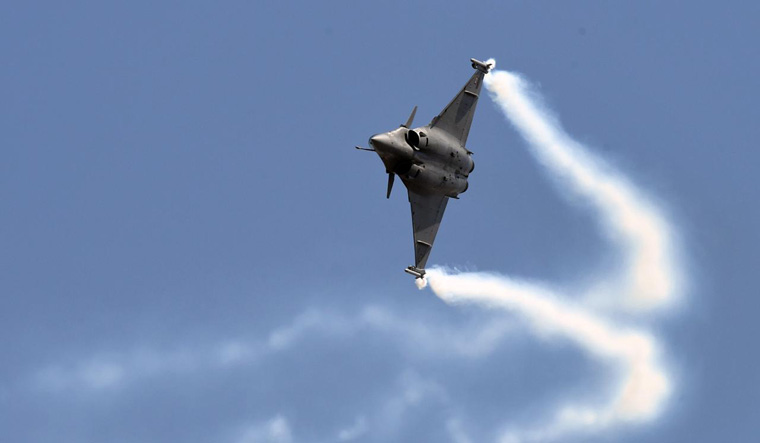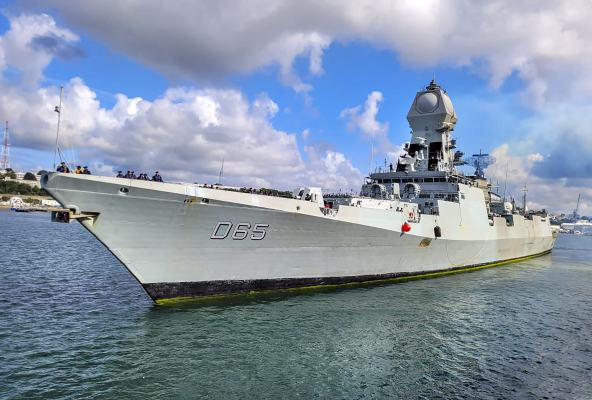
ISRO Chairman S. Somnath speaks with the media after offering prayers at a temple ahead of ISRO's Chandrayaan-3 mission, in Tirupati, Thursday, July 13, 2023. A PTI Photo
SRIHARIKOTA, AP (PTI): As the clock ticks for ISRO's high-profile launch of the year, the Chandrayaan-3 lunar mission, all eyes are on the country's space agency whose scientists are keen to taste success with a soft landing on lunar surface and put the country in an elite club of nations that have accomplished the challenging task.
'Fat boy' LVM3-M4 rocket will carry Chandrayaan-3 today as part of the country's ambitious moon mission. The Indian Space Research Organisation will be launching the hugely anticipated mission from this spaceport at 2.35 pm on today. The soft landing on moon's surface is planned for late August.
Chandrayaan-2 failed to achieve the desired soft landing on the moon surface in 2019, leaving the ISRO team dejected. Images of an emotional then ISRO chief K Sivan being consoled by Prime Minister Narendra Modi who was present to achieve the rare feat, remains vivid in the memory of many.
Scientists at the Satish Dhawan Space Centre here, after investing many hours of hard work, now aim at mastering the technology of soft-landing on the surface of the moon. A success would make India only the fourth country to achieve the feat after the United States, China and the former Soviet Union.
Chandrayaan-3 is the third lunar exploration mission ready for take off in the fourth operational mission (M4) of LVM3 launcher. ISRO is crossing new frontiers by demonstrating soft-landing on the lunar surface by its lunar module and demonstrating roving on the lunar terrain, the space agency said.
The 25.30 hour countdown for the launch is underway.
The mission is expected to be supportive to future interplanetary missions.
Chandrayaan-3 mission consists of an indigenous propulsion module, lander module and a rover with an objective of developing and demonstrating new technologies required for inter-planetary missions.
The largest and heaviest LVM3 rocket (formerly GSLV MkIII), fondly called as 'fat boy' by ISRO scientists for its heavy lift capability, has completed six consecutive successful missions.
Today's mission is the fourth operational flight of LVM3 which aims to launch the Chandrayaan-3 spacecraft into a Geo Transfer Orbit.
The launch window has been fixed for July, similar to that of Chandrayaan-2 mission (July 22, 2019) because the earth and moon would be closer to each other during this period of the year.
Today's mission follows Chandrayaan-2 where scientists aim to demonstrate various capabilities including reaching the orbit of the moon, making a soft-landing on the lunar surface using a lander, and a rover coming out of the lander to study the surface of the moon.
According to scientists, around 16 minutes after lift-off, propulsion module is expected to get separated from the rocket and would orbit the earth for about 5-6 times in an elliptical cycle with 170 km closest and 36,500 km farthest from earth moving towards the lunar orbit.
The propulsion module along with the lander, after gaining speed would proceed for an over a month long journey towards reaching the orbit of the moon until it goes 100 km above the lunar surface.
After reaching the desired position, the lander module would begin its descent for a soft landing on the south pole region of the moon and this action is expected to take place on August 23 or 24, scientists at ISRO said.
The moon's south pole region has been chosen because the Lunar South Pole remains much larger than that at the North pole. There could be a possibility of presence of water in permanently shadowed areas around it.
The significance about Chandrayaan-3 mission, unlike its unsuccessful predecessor, is that the Propulsion Module has a payload -- SHAPE -- Spectro- polarimetry of HAbitable Planet Earth to study earth from lunar orbit.
ISRO said the SHAPE is an experimental payload to study the spectro-polarimetric signatures of the Earth in the near-infrared wavelength range.
Apart from the SHAPE payload, the Propulsion Module's main function is to carry the Lander Module from launch vehicle injection orbit to till lander separation.
The lander module after landing on the surface of the moon has payloads including RAMBHA-LP which is to measure the near surface plasma ions and electrons density and its changes, ChaSTE Chandra's Surface Thermo Physical Experiment -- to carry out the measurements of thermal properties of lunar surface near polar region and ILSA (Instrument for Lunar Seismic Activity) to measure seismicity around the landing site and delineating the structure of the lunar crust and mantle.
The Rover, after the soft-landing, would come out of the lander module and study the surface of the moon through its payloads APXS - Alpha Particle X-Ray Spectrometer - to derive the chemical composition and infer mineralogical composition to further enhance understanding of lunar surface.
The Rover, which has a mission life of 1 lunar day (14 Earth days) also has another payload Laser Induced Breakdown Spectroscope (LIBS) to determine the elemental composition of lunar soil and rocks around the lunar landing site, ISRO said.
 Previous Article
Previous Article Next Article
Next Article












The Indian Air Force, in its flight trials evaluation report submitted before the Defence Ministry l..
view articleAn insight into the Medium Multi-Role Combat Aircraft competition...
view articleSky enthusiasts can now spot the International Space Station (ISS) commanded by Indian-American astr..
view article